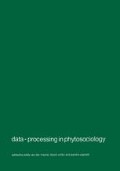Abstract
In phytosociological tables species and relevés are ordered in such a way that the species with a more or less similar distribution pattern over the relevés are grouped together and, similarly, relevés with a more or less similar species content are placed next to one another. As stated previously (Werger 1974a), membership of a species to a species-group is not necessarily determined by association with any individual species in that group, but can also be based on the restriction to the general distribution range in the table of a group of associated species. The same applies mutatis mutandis to the relevés belonging to a relevé group (cf. Hull 1964–65). In this way clusters of relevés characterized by groups of differential species are easily spotted in the table (cf. Van der Maarel et al. 1978).
Nomenclature of species follows usage in Werger (1973).
Contribution from the International Working Group on Data Processing m Phytosociology. Part of this paper it based on an unpublished lecture presented at the Prague meeting of the Working Group (Stockinger & Holzner 1973b). Copies of that manuscript and of a description of the mathematical background of the method (Stockinger & Holzner 1973a) are available from the first author The computer program can be studied at Vienna, Nijmegen, and at the C.S.I.R.O., St. Lucia Qld., Australia (Dr. M B. Dale).
Supported by a grant from the ‘Fonds zur Förderung der wissenschaftlichen Forschung’, Austria.
Access this chapter
Tax calculation will be finalised at checkout
Purchases are for personal use only
Preview
Unable to display preview. Download preview PDF.
References
Holzner, W. & Stockinger. F. 1973. Der Einsatz von Elektronenrechnern bei der pflanzensoziologischen Tabellenarbeit. Österr. Bot. Z. 121: 303–309.
Hull. D L 1964–65. The effect of essentialism on taxonomy. Two thousand years of stasis. I+ II. Brit J Phil Sci 15: 314–326. ibid. 16: 1–18.
Hull. D.L. 1970. Contemporary systematic philosophies. Ann Rev. Ecol. Syst. 1: 19–54.
Kaplan. A. 1964 The conduct of inquiry. Chandler. San Francisco.
Maarel, E.. van der, J.G.M. Janssen & J.W.M Louppen. 1978. TABORD, a program for structuring phytosociological tables. Vegetatio 38: 143–156.
McIntosh, R P. 1973 Matrix and plexus techniques. In R.H. Whittaker (ed.). Ordination and classification of communities. Handb, Veg. Sc. 5: 157–191. Junk. The Hague.
Stockinger, F.J. & Holzner. W. 1972. Rationelle Methode zur Auswertung pflanzensoziologischer Aufnahmen mittels Elektronenrechner. In: E. van der Maarel & R. Tüxen (eds.), Grundfragen und Methoden in der Pflanzentoziologie. pp. 239–248. Junk. The Hague.
Stockinger. FJ. & Holzner. W 1973a Prinzipien einer Implementierung des pflanzensoziologischen Zerlegungsproblems Mitt. Bot Arbeitsgem. Oberösterr. Landesmus. Linz 4: 87–106
Stockinger, F.J & Holzner. W. 1973b. Grundlegende Fragen bei der Verwendung von EDV in der Pflanzensoziologie. Symposium International Working Group for Data Processing in Phytosociology. Prague (manuscript )
Werger, M.J.A. 1973. Phytosociology of the Upper Orange River Valley. South Africa. V & R, Pretoria (Thesis Nijmegen).
Werger. M.J.A. 1974a. On concepts and techniques applied in the Zürich-Montpellier method of vegetation survey. Bothalia 11: 309–323.
Werger. M.J.A. 1974b. The place of the Zürich-Montpellier method in vegetation science. Folia Geobot Phytotax. 9: 99–109
Westhoff, V &. E. van der Maarel. 1973. The Braun-Blanquet approach. In R.H. Whittaker (ed.). Ordination and classification of communities. Handb. Veg. Sc. 5: 619–726. Junk. The Hague.
Whittaker, R.H. 1962 Classification of natural communities. Bot. Rev. 28: 1–239.
Author information
Authors and Affiliations
Editor information
Editors and Affiliations
Rights and permissions
Copyright information
© 1980 Dr. W. Junk bv Publishers, The Hague
About this chapter
Cite this chapter
Holzner, W., Werger, M.J.A., Ellenbroek, G.A. (1980). Automatic Classification of Phytosociological Data on the Basis of Species Groups. In: van der Maarel, E., Orlóci, L., Pignatti, S. (eds) Data-processing in phytosociology. Advances in vegetation science I, vol 1. Springer, Dordrecht. https://doi.org/10.1007/978-94-009-9194-1_16
Download citation
DOI: https://doi.org/10.1007/978-94-009-9194-1_16
Publisher Name: Springer, Dordrecht
Print ISBN: 978-94-009-9196-5
Online ISBN: 978-94-009-9194-1
eBook Packages: Springer Book Archive

